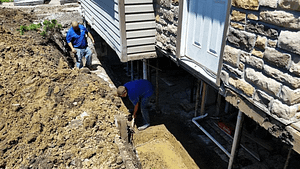The Ultimate Guide To Best Basement Waterproofing
The Ultimate Guide To Best Basement Waterproofing
Blog Article
The Facts About Best Basement Waterproofing Revealed
Table of ContentsSome Known Questions About Best Basement Waterproofing.Excitement About Best Basement WaterproofingBest Basement Waterproofing - TruthsSome Ideas on Best Basement Waterproofing You Should KnowThe Facts About Best Basement Waterproofing Uncovered
AdvantaClean's skilled professionals and service technicians will locate the water source. If wall or piece cracks are present, we will infuse polyurethane and epoxies right into the splits and secure the compromise, avoiding additional wetness from getting in.Mounting cellar air flow systems, conditioning systems, or cellar dehumidifier systems to obtain water out of your basement. Choosing AdvantaClean's basement waterproofing services is an effective way to deal with moisture and prevent mold and mildew from endangering the framework of your home and the health and wellness of your household.
If there's condensation on the outside of the foil, you have high moisture in your cellar. Fix it with a portable space dehumidifier or a whole-house humidifier system rather than waterproofing products. If the foil has condensation on the inside surface area (following to the wall), the soil around your house might be naturally damp from a high water table or poor dirt drain.
You can waterproof just your interior wall surfaces, which might resolve the issue. Once they dry out, they stick completely to concrete and masonry walls.
Not known Facts About Best Basement Waterproofing
Concrete waterproof finishes can't be applied to previously painted surface areas; inspect the label. Understood as densifiers, they are appropriate just for wall surfaces that have not been repainted or secured.
You brush, roll, or spray it on a lot even more heavily one gallon covers simply 75 square feet, not the 300 square feet normal with typical paint. Waterproof paint is fine for DIY application. You can use it over repainted surface areas, and paint over it once it's treated (one gallon expenses $37).
It can set you back $10,000 to $15,000, depending on the work needed (Best Basement Waterproofing). Outside waterproofing entails excavating all around the home to the full depth of the structure walls, after that mounting a water-proof covering or membrane layer covered by drainage panels.
Rumored Buzz on Best Basement Waterproofing
A basement without waterproofing is kind of like that. Your cellar doesn't want to go through a downpour without proper security just as much as you don't want to.

Outside waterproofing is a waterproofing approach that entails securing your home from the exterior. The structure wall surfaces are then cleansed, secured, and covered with a water-proof membrane layer or sealer.
Some Of Best Basement Waterproofing
It's a much more engaged procedure that requires excavating up your lawn, which is costly and time-consuming. Exterior waterproofing involves eliminating everything surrounding your house, including porches, driveways, pathways, landscaping, AC devices, decks, and more. If any of the job was done improperly and water is still entering your basement, there isn't much you can do to correct or repair it.
Interior basement waterproofing includes waterproofing from the within. Any water that leakages into your basement is redirected prior to it touches your flooring.
It's this website a reliable technique to waterproof your basement. The drawback of indoor cellar waterproofing mainly concerns the installment procedure. This approach needs saved items, furniture, and built-in shelving or cupboards to be relocated from touching the cellar walls. And throughout installment, your cellar can't be utilized. The most significant distinction in between both techniques is this: Outside waterproofing is a preventative remedy and indoor waterproofing is a restorative solution.
Fascination About Best Basement Waterproofing
To conclude, exterior and interior basement waterproofing are both reliable approaches of protecting your home from water damage. Outside waterproofing develops explanation an obstacle that protects against water from entering your home, while indoor waterproofing redirects water that does enter your home. And it is very important to note that exterior waterproofing is an expensive and turbulent installation process when contrasted to indoor waterproofing.
Whichever technique you select, make certain you pick a trustworthy and credible specialist for the task. Both methods call for seasoned employees to deal with the job. If you have any kind of inquiries concerning cellar waterproofing, please get to out to us. And if you remain in our service area and have water in your cellar, contact us for a cost-free, no-obligation home evaluation.
You can fill up out our form below. Best Basement Waterproofing, start a chat in the lower right-hand edge, or call us at 1-800-827-0702
Report this page